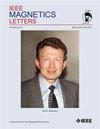磁子-光子耦合强度的增强:空间分布效应
IF 1.1
4区 物理与天体物理
Q4 ENGINEERING, ELECTRICAL & ELECTRONIC
引用次数: 0
摘要
磁子-光子混合系统在量子信息处理中具有潜在的应用前景。磁场强度的空间分布对提高耦合强度起着至关重要的作用。我们研究了在S到C波段的双频范围内,利用地面上有缺陷的平面波导的强磁子-光子耦合。采用双倒裂环谐振器作为光子谐振器,钇铁石榴石(YIG)颗粒作为磁振子源。磁振子和光子模式之间的相互作用是由微带线上磁场空间分布的变化所控制的。将铁氧体样品放置在A、B和c三个不同的位置,通过改变yeg在微带线上不同位置的位置,将耦合强度$g$从188 MHz调谐到281 MHz。通过控制YIG的位置,使自旋数归一化耦合强度显著提高到50%。因此,它为量子比特信息交换提供了另一种自由度。同时确定了协同度、耦合常数等参数。这项工作为开发具有平面几何可调高增益磁-光子耦合系统的创新混合系统铺平了道路。本文章由计算机程序翻译,如有差异,请以英文原文为准。
Enhancement of Magnon–Photon Coupling Strength: Effect of Spatial Distribution
Magnon–photon hybrid systems have potential applications in quantum information processing. The spatial distribution of magnetic field intensity plays a crucial role in enhancing coupling strength. We have investigated strong magnon–photon coupling using a planar waveguide with defects in the ground for dual-frequency ranging from S to C band. Dual inverted split ring resonators were used as a photon resonator, and a yttrium iron garnet (YIG) pellet acted as a magnon source. The interaction between magnon and photon modes was manipulated by variations in the spatial distribution of the magnetic field along the microstrip line. The ferrite sample was placed at three different positions, viz., A, B, and C. The coupling strength
$g$
求助全文
通过发布文献求助,成功后即可免费获取论文全文。
去求助
来源期刊

IEEE Magnetics Letters
PHYSICS, APPLIED-
CiteScore
2.40
自引率
0.00%
发文量
37
期刊介绍:
IEEE Magnetics Letters is a peer-reviewed, archival journal covering the physics and engineering of magnetism, magnetic materials, applied magnetics, design and application of magnetic devices, bio-magnetics, magneto-electronics, and spin electronics. IEEE Magnetics Letters publishes short, scholarly articles of substantial current interest.
IEEE Magnetics Letters is a hybrid Open Access (OA) journal. For a fee, authors have the option making their articles freely available to all, including non-subscribers. OA articles are identified as Open Access.
 求助内容:
求助内容: 应助结果提醒方式:
应助结果提醒方式:


